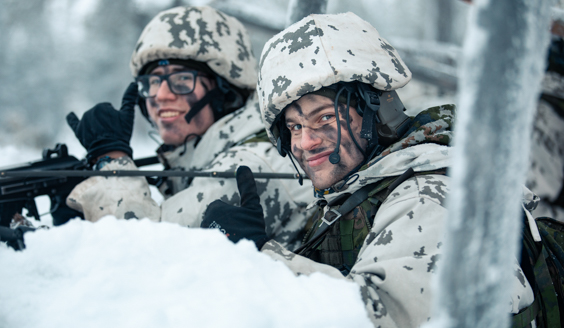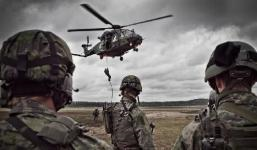
Conscript service and training
The objective of military training is to sustain the readiness of the Finnish Defence Forces and to train individuals liable for military service in tasks of national defence. Military training is provided annually for approximately 21,000 conscripts. Over the past years, the number of women applying for voluntary military training has been on the rise.
Military service can offer diverse benefits for individuals. The Finnish Defence Forces offers more than 500 different tasks of different levels for new conscripts. This means that many conscripts can complete their service in meaningful tasks that match their abilities. Military training provides motivated conscripts with professional skills that are also useful after the service, as well as good social and presentation skills, abilities to work in a group, not forgetting lifelong friendships.
During military service, conscripts can test their physical and psychological resources and try new things under the supervision of experienced instructors. Military service is part of individuals’ training and work careers. The Finnish Defence Forces promotes the recognition of skills acquired during military service in cooperation with educational institutions and employers.
When young people begin their military service, they encounter novelties: shared accommodation, regulated use of time, military discipline and physically straining activities. For some conscripts, this will temporarily increase their psychological load. This will be taken into account at the initial stage of military service. Service condition arrangements abide by the following principles:
- Fostering justice and equality at all times
- Reacting to personal problems appropriately by taking them seriously
- Respecting the confidentiality of personal matters
- Collecting feedback and reacting to this feedback constructively
The social skills of conscripts are developed as part of small group training in the wartime section composition. Training emphasises the importance of cooperation between the combat fire team and intrapersonal responsibility for looking after each other. Leadership training highlights encountering people as individuals, building-up of trust and caring for subordinates.
Military training educates soldiers who comprehend the rightfulness of national defence and remain capable of making ethically sound choices and decisions. Ethical education during military training emphasises the value of each human being, the ability to appreciate differences, respect for individuals and the sense of responsibility. The Finnish Defence Forces has zero tolerance for bullying, harassment or hazing. All activities conducted are based on equal and non-discriminative treatment.
Structure of conscript training
Military training comprises varying training phases and modules. All persons liable for military service start from the same line. Depending on the given training, military service takes 165, 255 or 347 days. In total, approximately 43% of conscripts serve for 347 days, some 14% for 255 days, and 43% for 165 days. Conscripts being trained for rank and file tasks serve for 165 days and those trained for rank and file tasks requiring special competence, as well as those undertaking unarmed service, serve for 255 days. Conscripts being trained as reserve officers, non-commissioned officers and for most demanding rank and file special tasks serve for 347 days.
Conscripts are selected for given training programmes based on the needs of the Finnish Defence Forces. The selections account for the conscripts’ willingness and suitability, as well as the results of instructor and peer evaluations. Competences that a person liable for military service has developed before entering into service will be acknowledged before entry into service with the aim of utilising these competences in future service tasks. Conscripts’ special competences will be utilised in special tasks.
Basic training phase
Once conscripts have completed the basic training phase, they master the soldier’s basic skills
The basic training phase takes six weeks. New conscripts are divided into sections based on the results of the survey completed before the service. Over the first few weeks, conscripts are familiarised with the daily service rhythm of the company-level unit and the brigade-level unit. During the basic training phase, conscripts learn the general grounds for military activities, as well as the soldier’s basic skills in survival, protection and security. This gives the conscripts in all the training branches the grounds for safe operation as an individual soldier, as a member of a combat fire team and as part of a section.
The basic military exam will be completed during the basic training phase, measuring personal knowledge and skills in weapons and marksmanship training, combat and marching training, as well as in physical education.
The training selections of conscripts will be made during the basic training phase. These selections determine the training branch, the basic course of which each conscript will complete during the training branch phase. While in basic training, conscripts can also apply for special tasks that correspond to their given competences and civilian education. These are communicated and applied for separately. Special tasks include the tasks of a graphic designer, ICT support, photographer or journalist.
Training branch phase
Individual skills and cooperation within sections are developed during the training branch phase
The training branch phase takes six weeks. During the phase, conscripts are provided with training regarding the critical skills within their training branch (basic course), and their service periods are determined. The goal of the basic course is to ensure that, after completing the course, trainees possess the basic skills and knowledge required in their training branch, know what to do when the readiness level is elevated, can use their personal and section-specific weapon or system in a combat situation and can carry out their combat tasks as part of their training branch section.
During the training branch phase, the level of conscripts’ skills and knowledge is tested by means of the training branch exam. Training badges are given to conscripts who are able to pass this exam.
During the training branch phase, suitable conscripts are assigned to the NCO course. The most suitable conscripts in terms of their leadership and learning skills are assigned to leadership training based on aptitude tests. These selections account for the willingness of conscripts and the need for leaders in the wartime composition of the Finnish Defence Forces.
Special training phase
Operational capability as part of training
The operational capability is trained starting from the basic training and training branch phase, continuing increasingly throughout the service. Operational capability training develops conscripts’ physical and psychological abilities alongside increasing workloads. During the special training phase, the objective of operational capability development is that, after completing the phase, soldiers are able to act as part of their wartime unit, while maintaining their operational capability, and that they are capable of participating in demanding military training and longer military exercises during the unit training period.
The special training phase takes six weeks. Individuals selected for leadership training start the NCO course at the beginning of the special training phase. The objective of the special training phase is that, after completing the period, conscripts who serve for 165, 255 or 347 days and are assigned to wartime rank duties possess the soldier’s skills and knowledge in line with their military, defence and training branch. Training gives the readiness to operate in tasks in line with the training branch, as part of a patrol, section and platoon. The advanced and supplementary training and specialist training required for each position are completed during the special training phase.
The training content during the special training and unit training phase for conscripts serving for 255 days is planned by accounting for garrison obligations, wartime task requirements, as well as combat training exercises and live firing exercises.
Unit training phase
Training objective: a competent wartime unit
The six-week unit training phase is the culmination point of conscript training. The most important training is arranged during the unit training phase. This training provides conscripts with the readiness to operate in their wartime tasks and to fulfil specific capability requirements.
Conscripts are assembled and placed in a wartime unit that is produced no later than by the beginning of the unit training phase. The units will be trained in their wartime composition that may also include an over-strength belonging to the unit. During the unit training phase, the unit’s training level will be measured and assessed in combat training and live firing exercises.
The unit training phase consists of unit training modules and military exercises, as well as the “Reservin polku” (Reservist’s path) course to be completed at the end of the phase. The module will take place after the final military exercise and before the end of service.
The training content in 2020s
The Finnish Defence Forces has updated conscript training and practices involved in the liability for military service by employing the Training 2020 programme. The programme has developed the call-up system, service selections, training system, as well as training methods. The development objective entails smoothing out the training path of individuals liable for military service all the way from being liable for call-up to finally being mustered out as a reservist in the FDF reserve.
With its training objectives set at a high level, this programme aims at conducting high-impact, cost-effective training that meets the challenges posed by changes in the future security environment. This effective and goal-oriented training will be beneficial both for the defence system and for individuals.
Utilising modern technologies, training accords with modern perceptions on learning and, thereby, endows trainees with an increasing responsibility over their own learning. Training will become endorsed and the achieved learning outcomes will be systematically measured.
The Training 2020 Programme has facilitated progress in the following aspects:
Call-ups and service selections
- Utilising digitalisation as an aid in information transmission. The Finnish Defence Forces’ E-service will be accessible by all persons liable for military service.
Modern training methods
- Simulation, online and virtual training will become a natural part of the training of a person liable for military service.
- Training will be modified to feature module structures - this supports in defining sub-objectives and ensuring even training quality. Transitions and waiting times will be reduced.
- The set competence objectives steer training implementation. The facilitating role of an instructor becomes pronounced. Training supports sustaining comprehensive capability, with psychological, social and ethical as its sub-capabilities.
Training system
- The set competence objectives will inform the evaluation of service times.
- The impact of the training system will be systematically assessed - the sub-areas of the training system are learning outcomes, time efficiency, cost efficiency, optimal use of resources and facilities.
- Readiness unit training will be further developed.
- Reserve training system will be further developed. In the future, the Finnish Defence Forces’ E-service will also cover the reservists’ needs.
- Demanding training exercise activities will be intensified. The set level of training objectives will remain high and the training implementation will be increasingly comprehensive.

Services
Regional offices
Regional offices will help you before and after your military service. Do not hesitate to contact us!
Contact us


